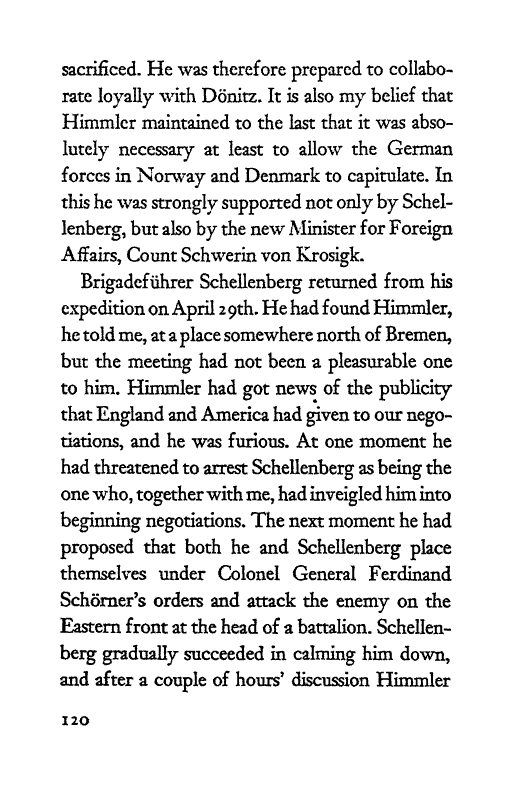Note: Translator Eric Lewenhaupt died in 1968, less than 70 years ago. Therefore, this work is protected by copyright, restricting your legal rights to reproduce it. However, you are welcome to view it on screen, as you do now. Read more about copyright.
Full resolution (TIFF) - On this page / på denna sida - Stockholm—Odense—Aabenraa—Copenhagen—Stockholm April 24th—May 7th

<< prev. page << föreg. sida << >> nästa sida >> next page >>
Below is the raw OCR text
from the above scanned image.
Do you see an error? Proofread the page now!
Här nedan syns maskintolkade texten från faksimilbilden ovan.
Ser du något fel? Korrekturläs sidan nu!
This page has been proofread at least once.
(diff)
(history)
Denna sida har korrekturlästs minst en gång.
(skillnad)
(historik)
sacrificed. He was therefore prepared to
collaborate loyally with Dönitz. It is also my belief that
Himmler maintained to the last that it was
absolutely necessary at least to allow the German
forces in Norway and Denmark to capitulate. In
this he was strongly supported not only by
Schellenberg, but also by the new Minister for Foreign
Affairs, Count Schwerin von Krosigk.
Brigadeführer Schellenberg returned from his
expedition on April 29th. He had found Himmler,
he told me, at a place somewhere north of Bremen,
but the meeting had not been a pleasurable one
to him. Himmler had got news of the publicity
that England and America had given to our
negotiations, and he was furious. At one moment he
had threatened to arrest Schellenberg as being the
one who, together with me, had inveigled him into
beginning negotiations. The next moment he had
proposed that both he and Schellenberg place
themselves under Colonel General Ferdinand
Schörner’s orders and attack the enemy on the
Eastern front at the head of a battalion.
Schellenberg gradually succeeded in calming him down,
and after a couple of hours’ discussion Himmler
<< prev. page << föreg. sida << >> nästa sida >> next page >>